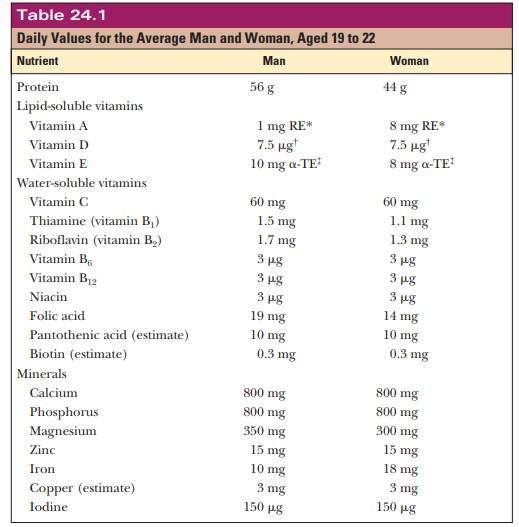Chapter: Biochemistry: Integration of Metabolism: Cellular Signaling
What are required nutrients?
What are required nutrients?
In humans, the catabolism of macronutrients (carbohydrates, fats, and proteins) to supply energy is an important aspect of nutrition. In the United States, most diets provide more than an adequate number of nutritional calories. The typical American diet is high enough in fat that essential fatty acids are seldom, if ever, deficient. The only concern is that the diet contains an adequate supply of protein. If the intake of protein is sufficient, the supply of essential amino acids is normally also sufficient.
Packaging on food items frequently lists the protein content in terms of both the number of
grams of protein and the percentage of the daily value (DV) suggested by the
Food and Nutrition Board under the auspices of the National Research Council of
the National Academy of Sciences (see Table 24.1). Daily values have replaced
the recommended daily allowances (RDAs) formerly seen on food packaging.

There are some key biochemical concepts to remember when analyzing a diet for protein content. First, there is no storage form for proteins. This means that proteins eaten in excess do a person no good in terms of satisfying that person’s future protein requirements. All protein consumed in excess of what is needed is turned into carbohydrate or fat, and the nitrogen from the amino group must be eliminated through the urea cycle. Ingesting too much protein can therefore be stressful on the liver and kidneys because of the overproduction of ammonia that must be eliminated. This is the same risk faced by certain athletes who take creatine to build muscles, because creatine is a highly nitrogenated compound.
Second, the essential amino acids must be consumed daily in order
for proteins to be made. It would be difficult to find a protein that did not
have at least one residue of each of the common 20 amino acids. Half of these
amino acids are essential, and if the diet is lacking or low in even one of
these essential amino acids, then protein synthesis is not possible. Not all
proteins are cre-ated equal. The protein efficiency ratio (PER) is an
indication of how complete a protein is. However, mixing proteins correctly is
very important, something that vegetarians know a lot about. A protein that is
very low in lysine would have a low PER value. If a second protein had a low
PER because it was low in tryptophan, it could be combined with the low-lysine
protein to give a combination with a high PER. However, this would work only if
the two were eaten together.
Third, proteins are always being degraded. Because of that, even if
a person does not seem to be doing any activities that would tend to require
protein replenishment, there is a constant need for quality protein in order to
maintain the body’s structures. Athletes are painfully aware of that fact. They
must train constantly, and they get out of shape quickly when they stop, the
effect being even more pronounced as the athlete reaches middle age.
Related Topics